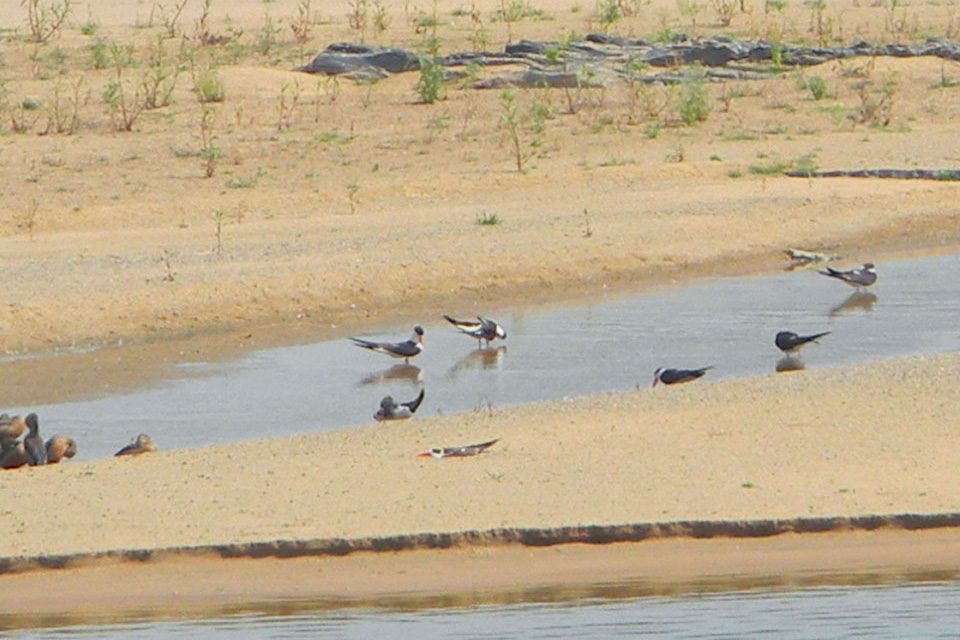 "
"
The Son Gharial Wildlife Sanctuary in Sidhi District of Madhya Pradesh, which was declared a wildlife sanctuary in 1981 by the State government to protect and preserve the faunal diversity of the river, specifically the critically endangered Gharial (Gavialis gangeticus), and the vulnerable Marsh Crocodile (Crocodylus palustris), is also a breeding ground for the Indian Skimmer (Rynchops albicollis), a hitherto unrecorded site. Birdlife International and IUCN have declared the skimmer as “Vulnerable” (see Birdlife factsheet on the species) based on its fast depleting numbers, which are assumed to be between 6000-7000 individuals only. The breeding of Indian Skimmers indicates that the sanctuary could be a potential Important Bird Area (IBA), and provides opportunities for locating other breeding sites of the birds, on Son River, and its tributaries — Banas, and Gopad. Earlier published reports showed the presence of some 111 species of common and rare birds in the sanctuary, with our observations adding 24 species to the sanctuary’s checklist.
Detailed scientific bird surveys are needed in the Son Gharial Wildlife Sanctuary (click for map) to comprehensively document its avifaunal diversity.
We made three visits to Son over a period of one year – April 13, 2011, January 28 and April 15, 2012 – predominantly to the gharial-spotting site of Jogdeha Ghat, passing through Bansagar Dam Shikargang, to an unnamed spot (24.40°N, 81.68°E). A random recording of birds revealed that Jogdeha Ghat sustains a larger number of wetland birds than any other sites visited along the Son River. 94 of these 111 species we observed were categorised as, of Least Concern, seven as Near Threatened, and ten as Threatened. In addition to the recording of the new breeding site of Indian Skimmer, we recorded the Common Pochard and other riverine bird species like Black-necked Stork, Black-headed Ibis, Great Thick Knee, and River Lapwing.
Fourteen Indian Skimmers were found nesting on a small sand island near the southern bank of the river, at Jogdeha, on April 15, 2012, which can be considered a new breeding colony that falls within Son. Prior studies did not indicate breeding of Skimmers in the sanctuary, the current recording was during the breeding season and hence indicates the presence of a virtual breeding population of Skimmers in the sanctuary in recent years.
The Indian Skimmer occurs on sandy rivers, and lakes of various sizes, and is principally adapted to feeding while flying over rivers. It breeds on sandy spits, or river islands. It frequently feeds near the edges of river channels, and lagoons—sometimes where the water depth is only three to four centimeters. The geography of Son River, and its tributaries, the Banas and Gopad rivers, provide an ideal habitat for this bird. The river has shallow channels and sandy islands throughout its length in Son, with the exception of four rocky beds, with large and deep pools and sparse vegetation at the beginning of the sanctuary, mainly at Shikargang, Kuldeha Bridge, and Jogdeha Bridge.
We observed that the Son River offers sandy banks and mid river islands that are ideal for the nesting of the species, along the whole stretch of the sanctuary (>100 km). Earlier studies seem to have restricted most of their activities to gharial breeding sites at Terideh Ghat, Jogdeha Ghat, Kherpur/Bicchheri Ghat, Kultideh, and Kheraini Ghat. However, there is little knowledge about the pattern of movements of the species. Although flooding regimes could be critical, breeding can only occur when water levels are low.
With a record of more than 80 birds at the confluence of Gopad and Son rivers in 2014, there is a possibility of identifying more breeding sites of Indian Skimmers on the Son River. Meanwhile, there is a clear need for more intensive surveys during the bird’s breeding season that is predominantly from March to May.
Considering that the Son also supports great avifaunal diversity along the river and adjoining areas, it is important to conserve the avifauna and their habitats along the Son River. Conservation of an area is achievable provided there is a reduction in anthropological pressures.

 CI is a non-profit, non-commercial portal that aims to facilitate wildlife and nature conservation by providing reliable information and the tools needed to campaign effectively.
CI is a non-profit, non-commercial portal that aims to facilitate wildlife and nature conservation by providing reliable information and the tools needed to campaign effectively.
Chosen as 'Picture of the Week'
Fourteen Indian Skimmers were found nesting on a small sand island near the southern bank of the river, at Jogdeha, which can be considered a new breeding colony that falls within the Son.